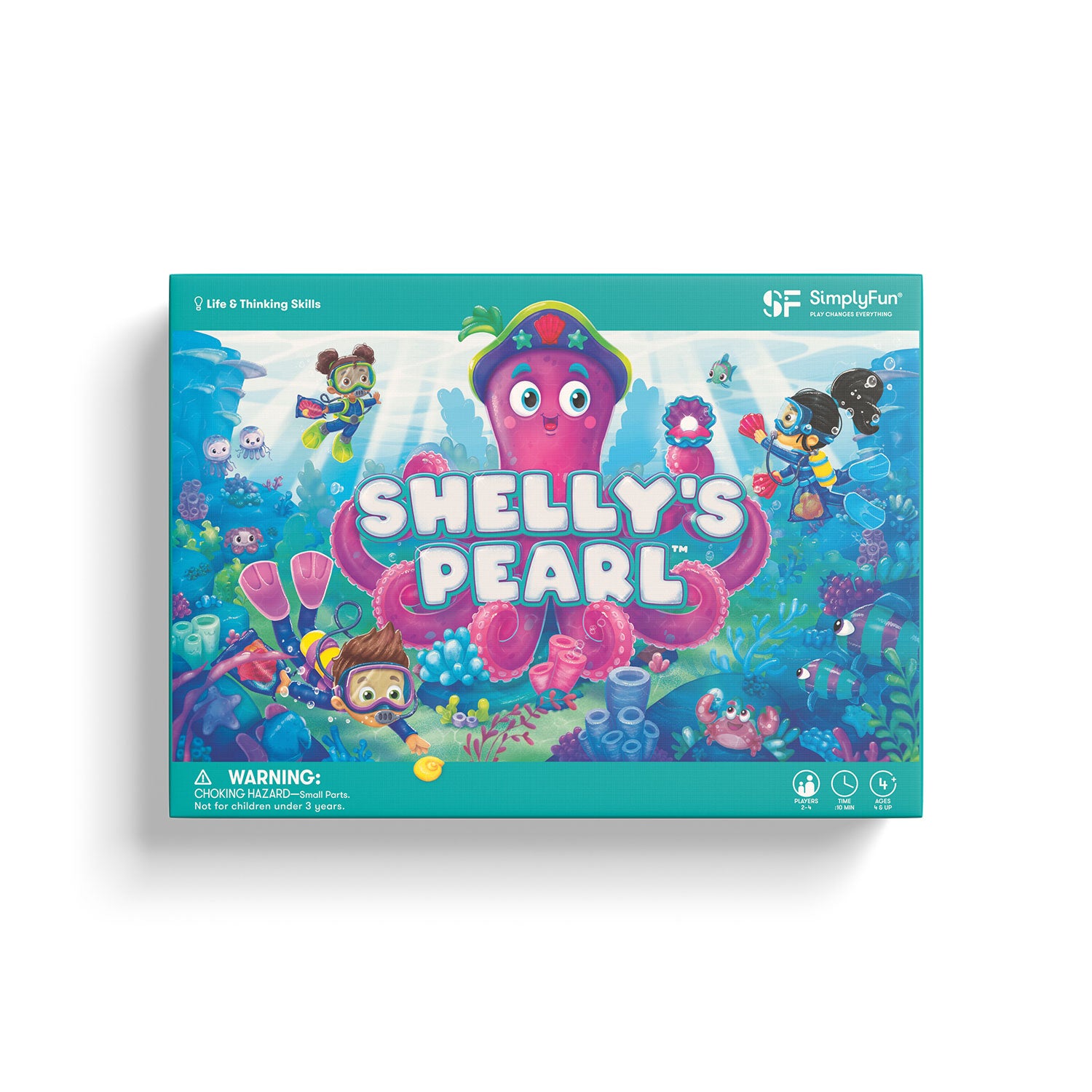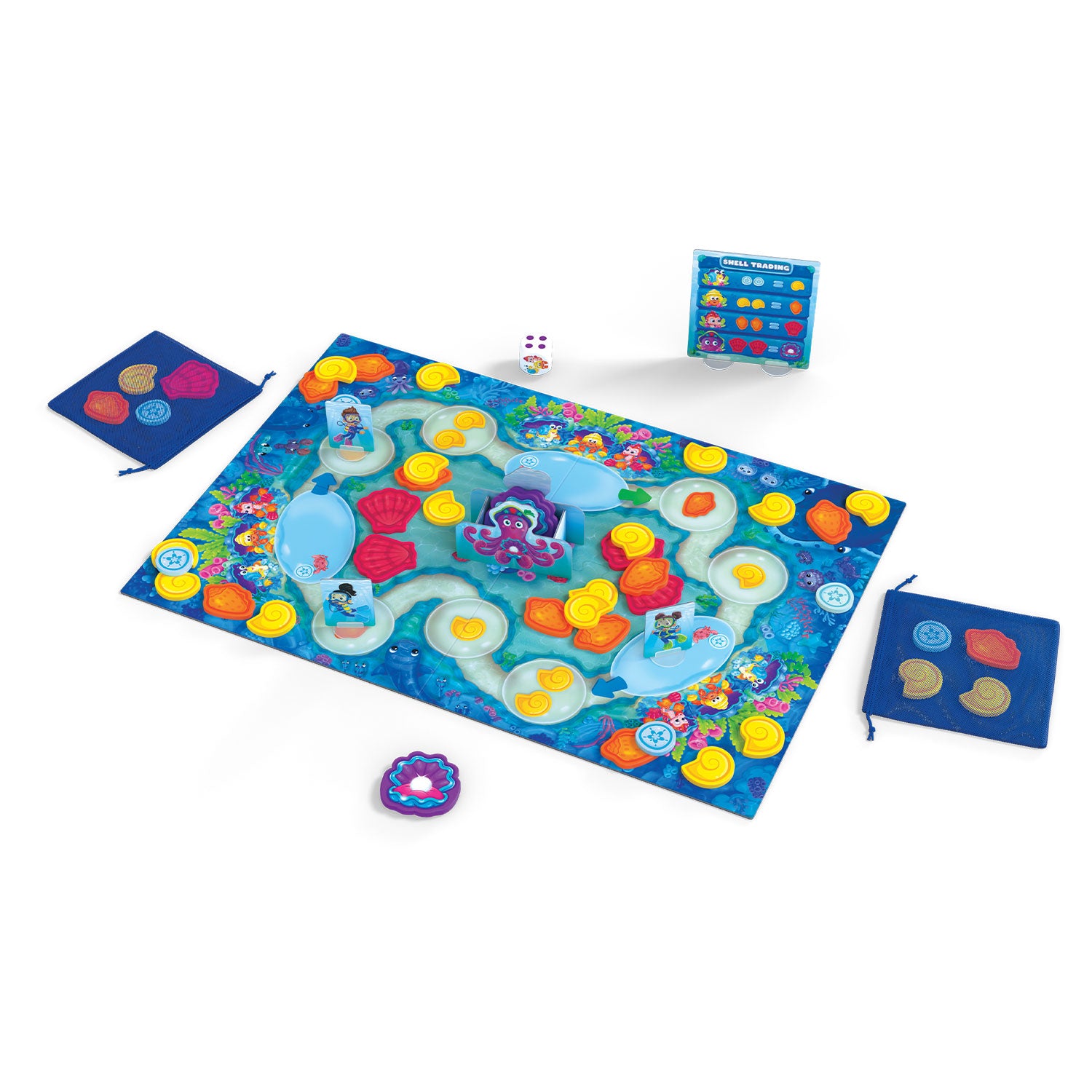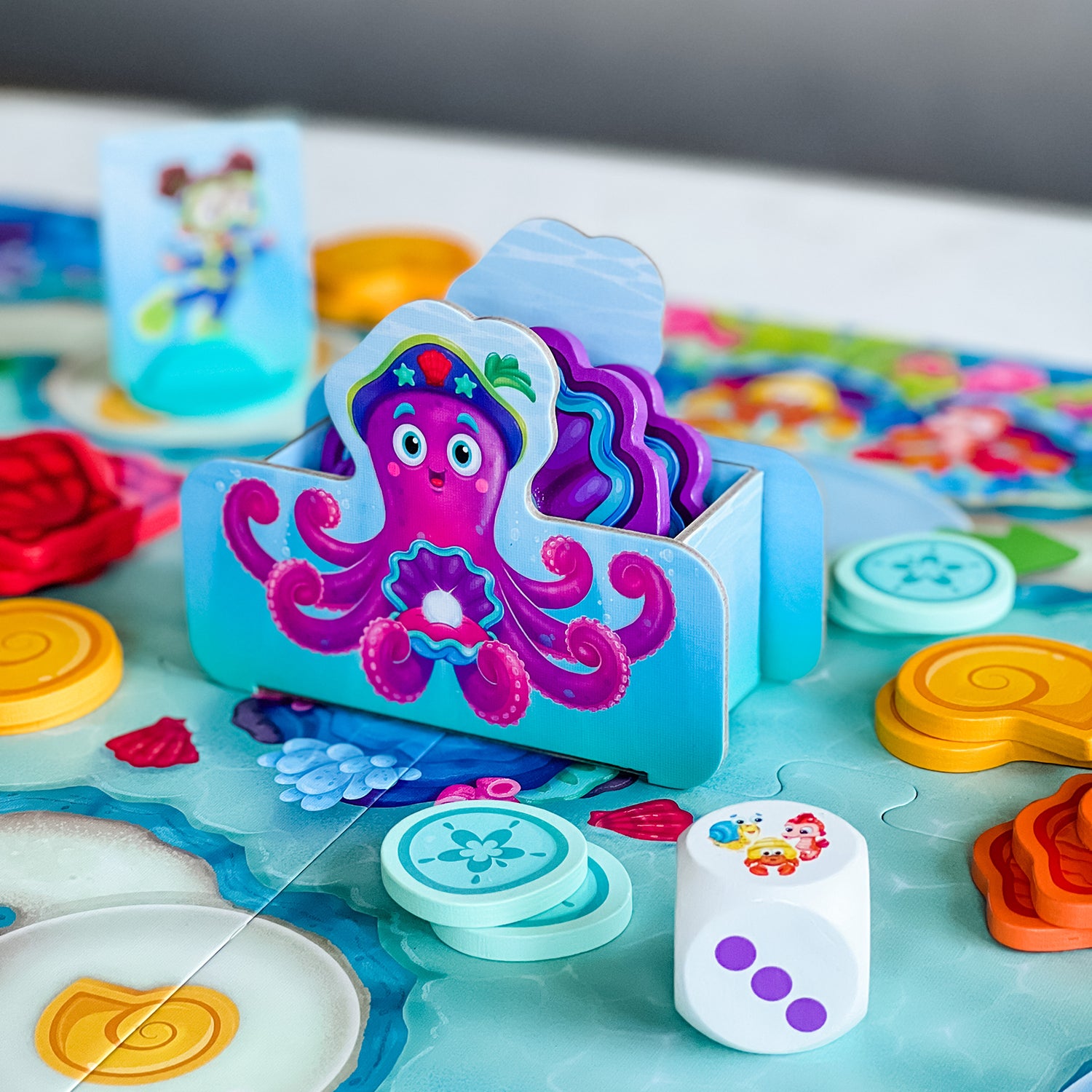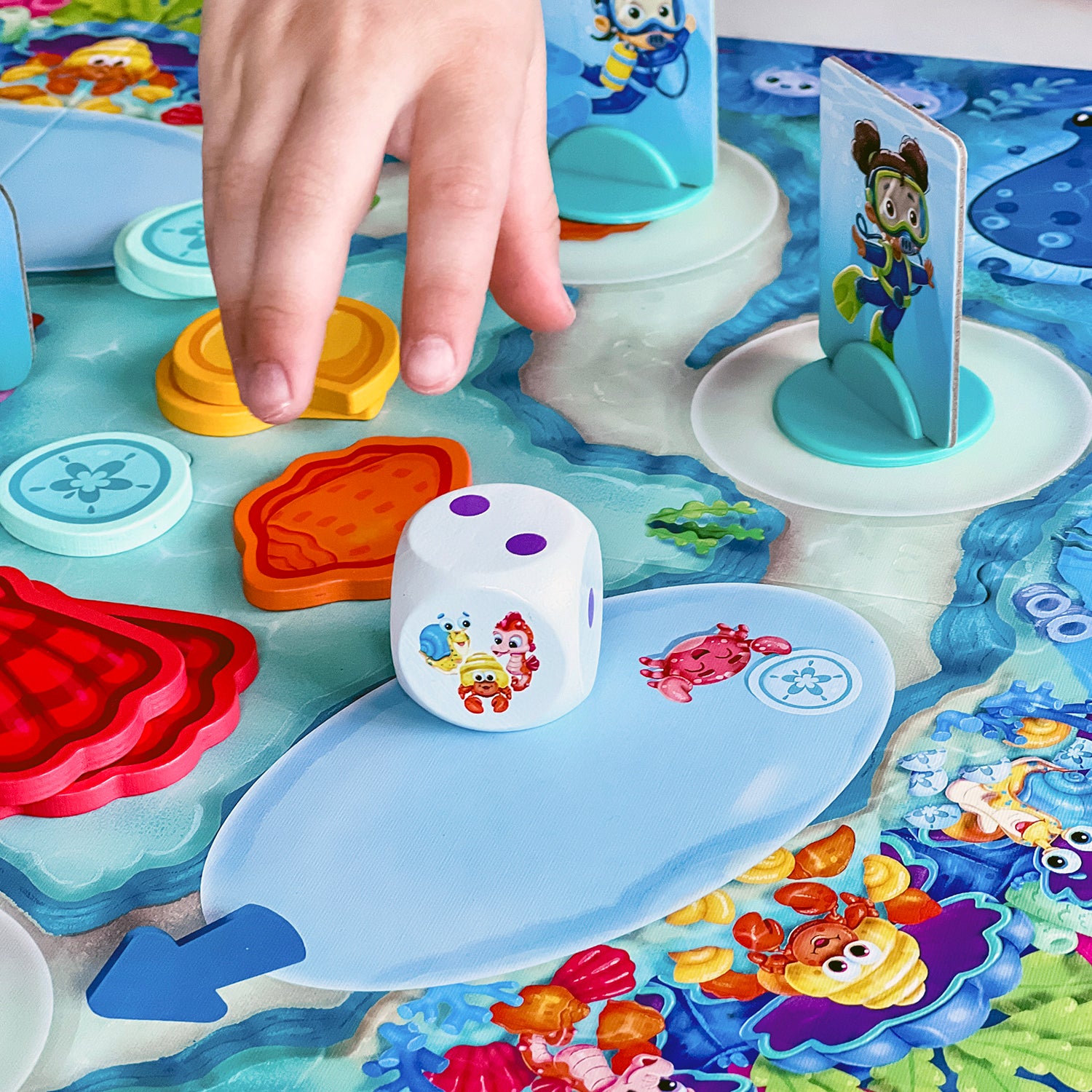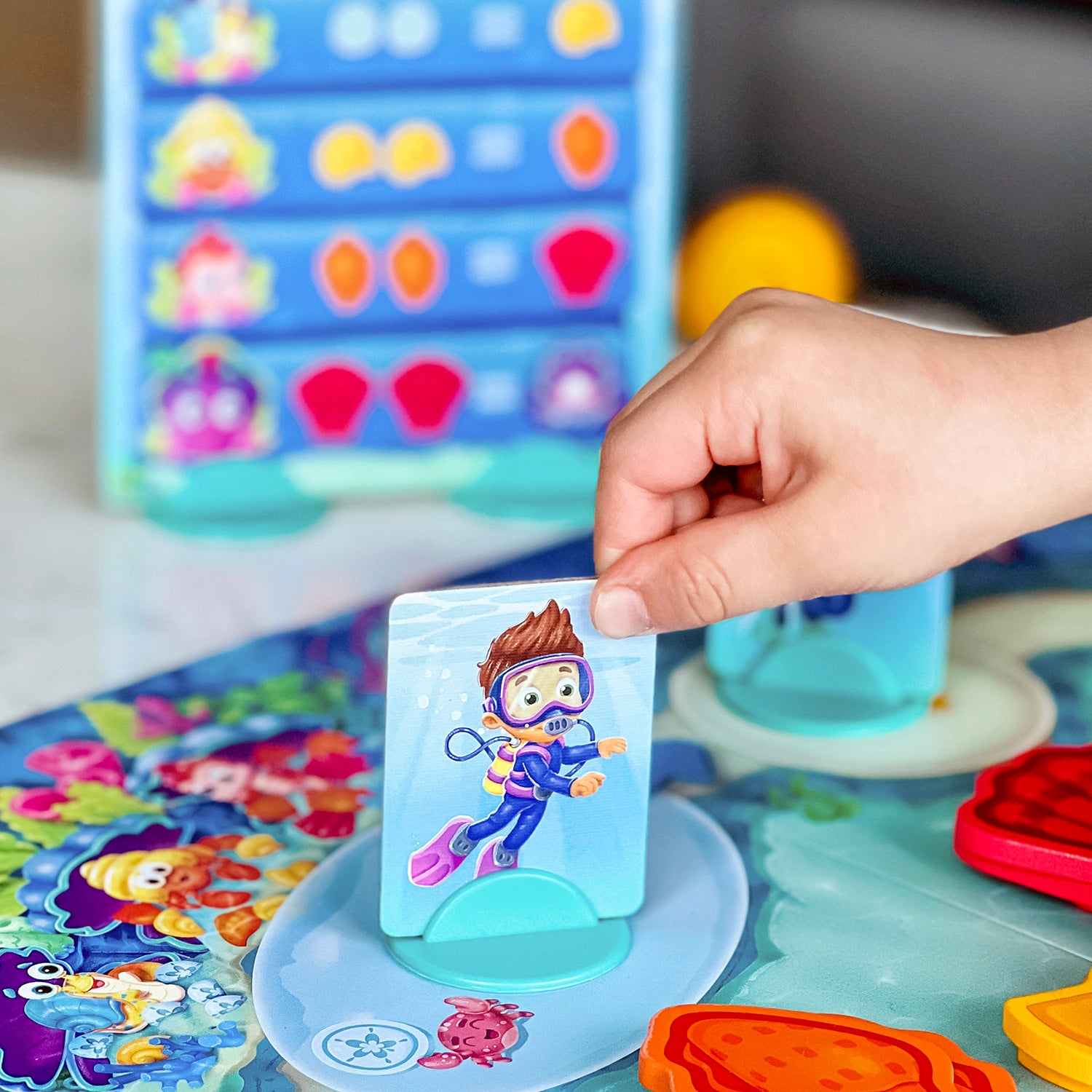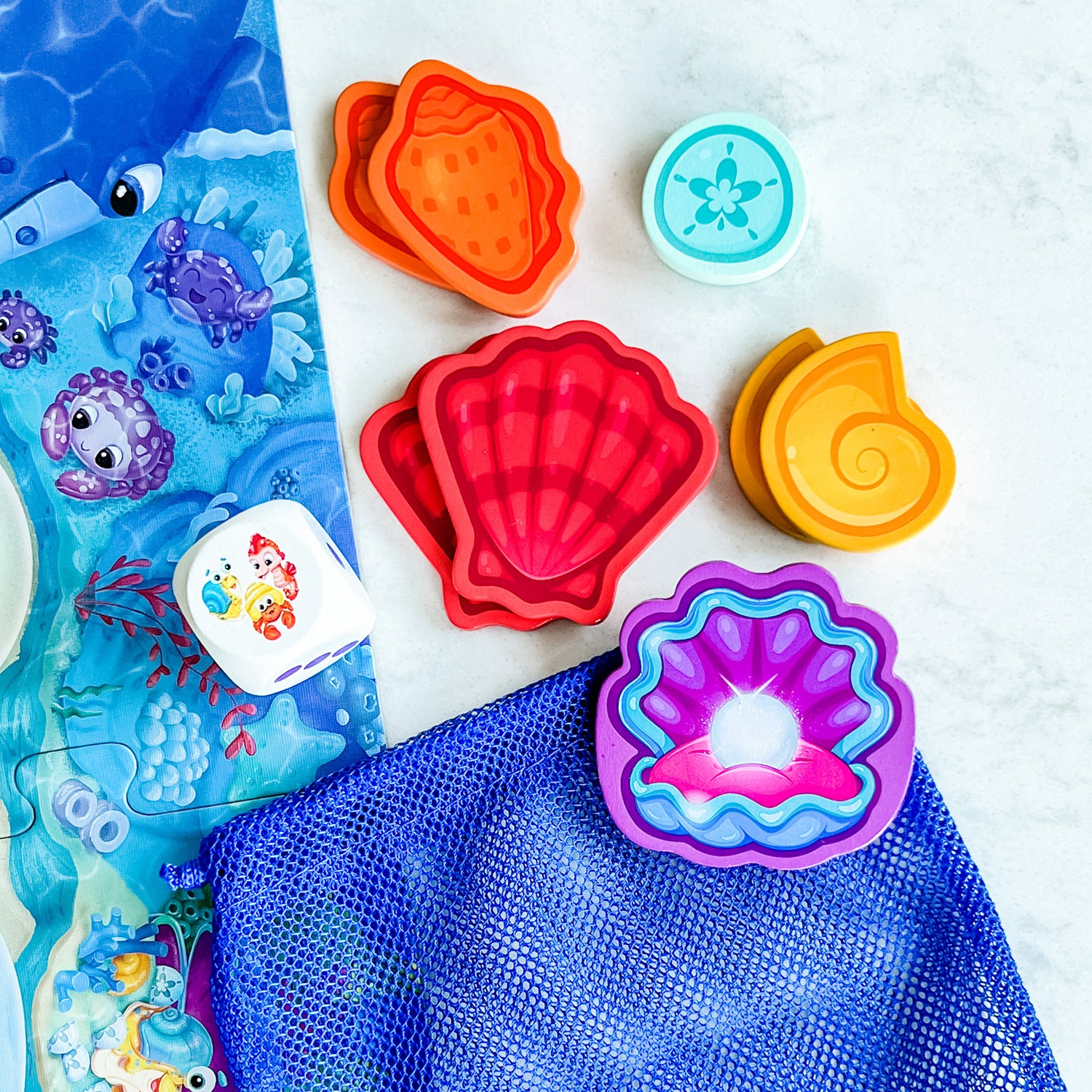Shelly's Pearl
Shelly's Pearl
2-4 players • 10 min • 4 & up
Focus: Trading
Couldn't load pickup availability
Enjoy exploring the ocean floor with your dive team collecting colorful shells to trade with Shelly the octopus. Each time you reach one of the three trading bubbles, collect a shell, and trade your smaller ones for larger ones. The game ends when everyone has collected their prize pearl and can “shellebrate” together! Shelly's personal pronouns are they/them, which is not part of game play, but provides the opportunity to discuss pronouns if desired.
Skills: Trading, Achieving Goals
Game Includes
Game Includes
- 1 Gameboard
- 4 Diver Pawns
- 4 Collection Bags
- 40 Shells
- 4 Prize Shells
- 1 Shelly the octopus
- 1 Shell Trading Card
- 1 Die
- 1 Rules Booklet
Share
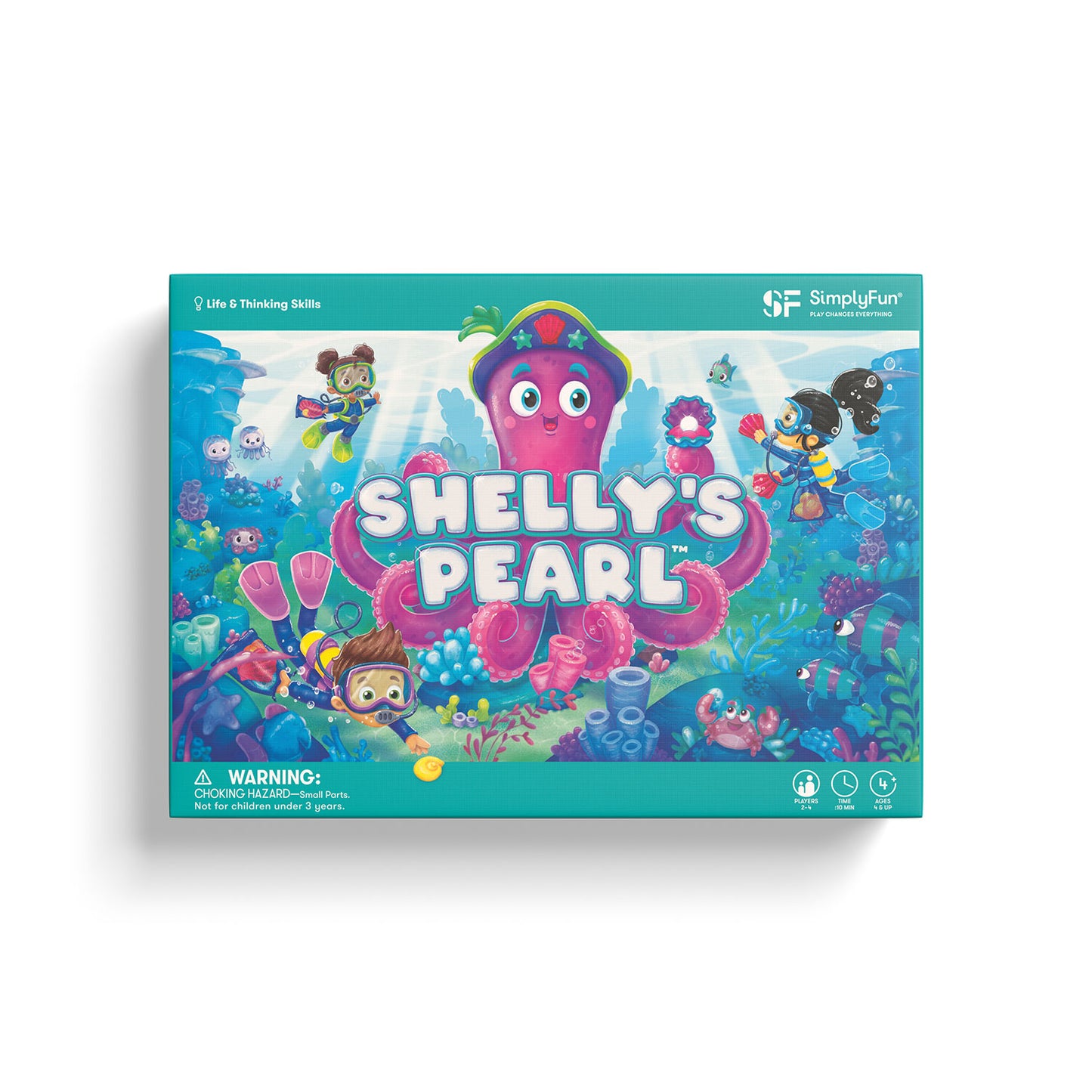
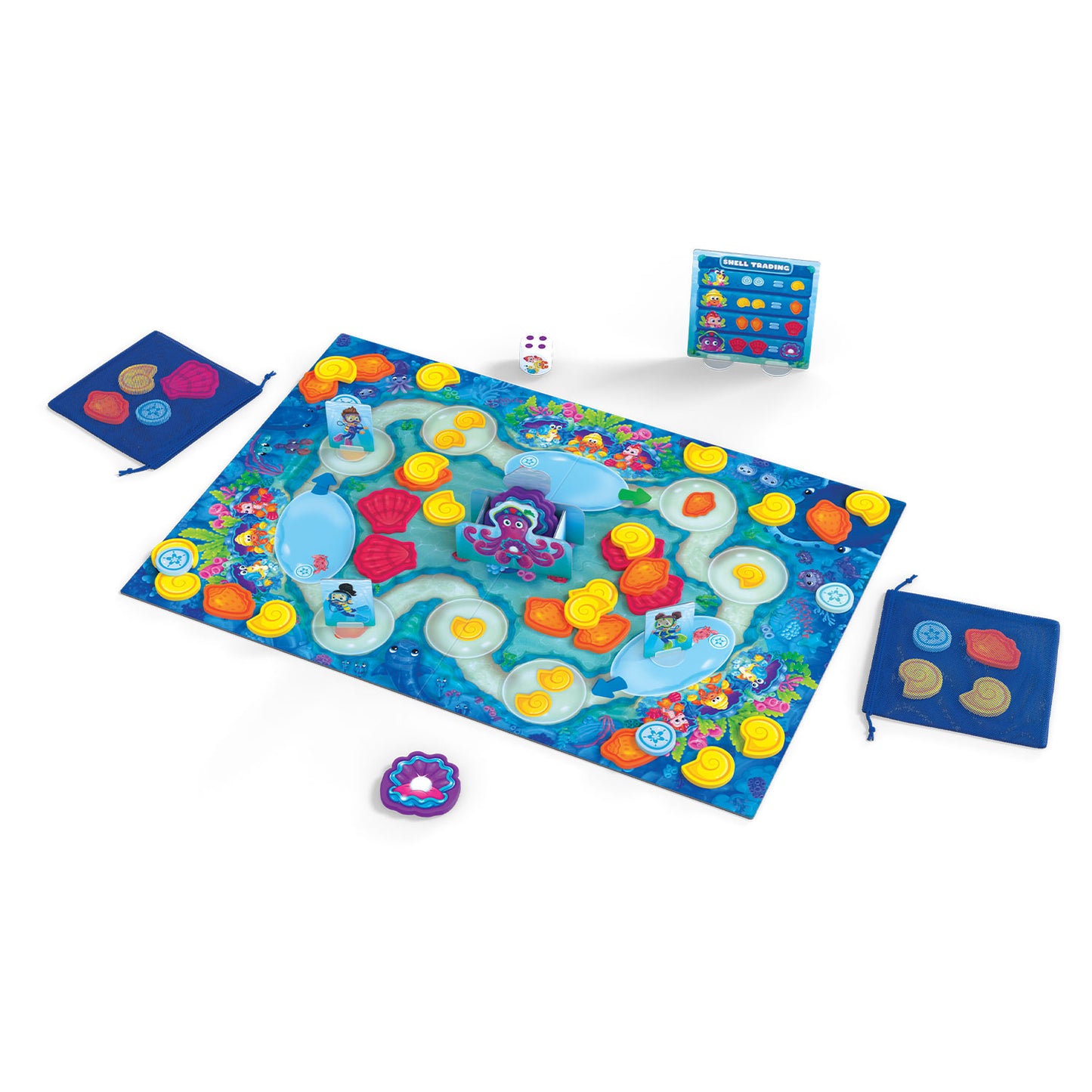
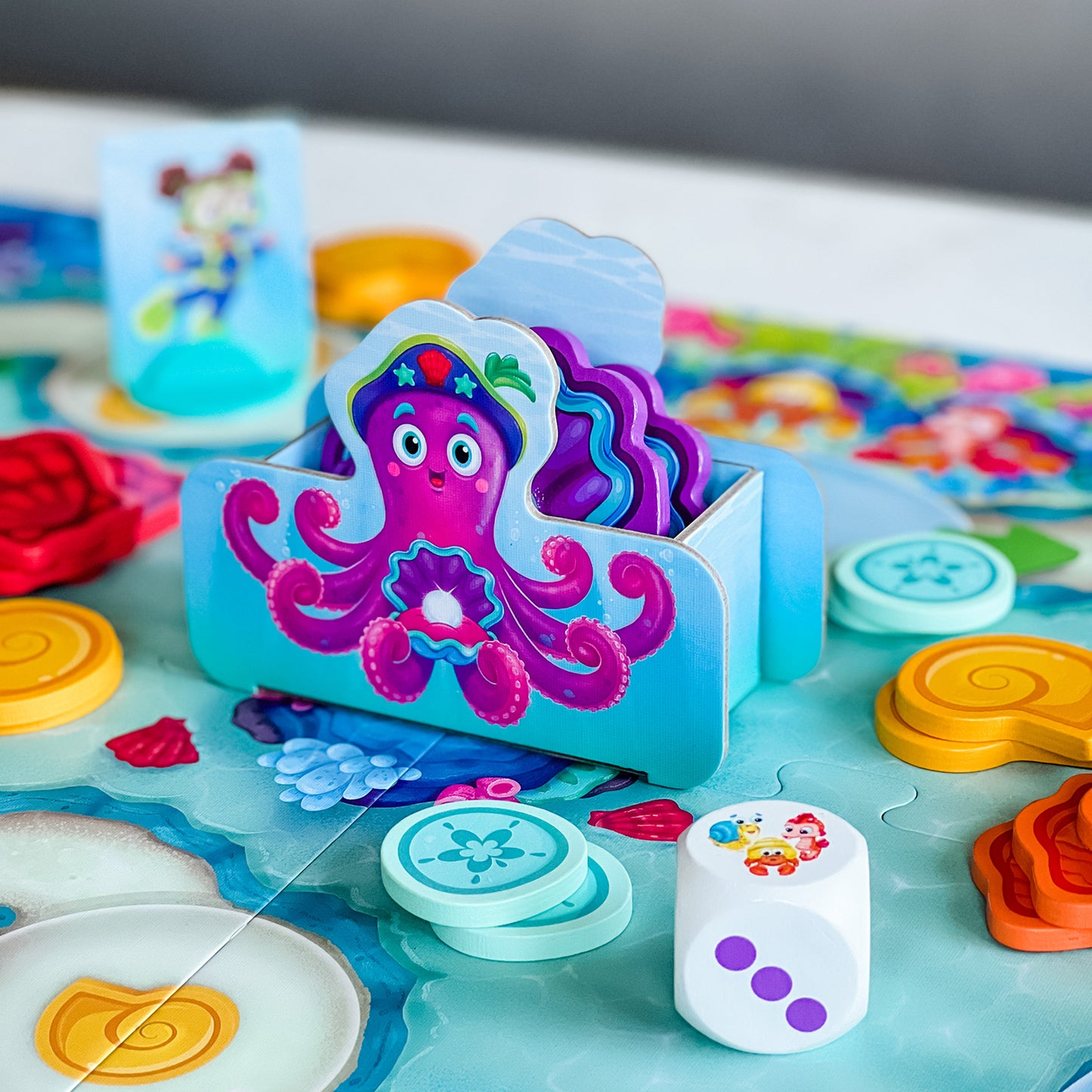
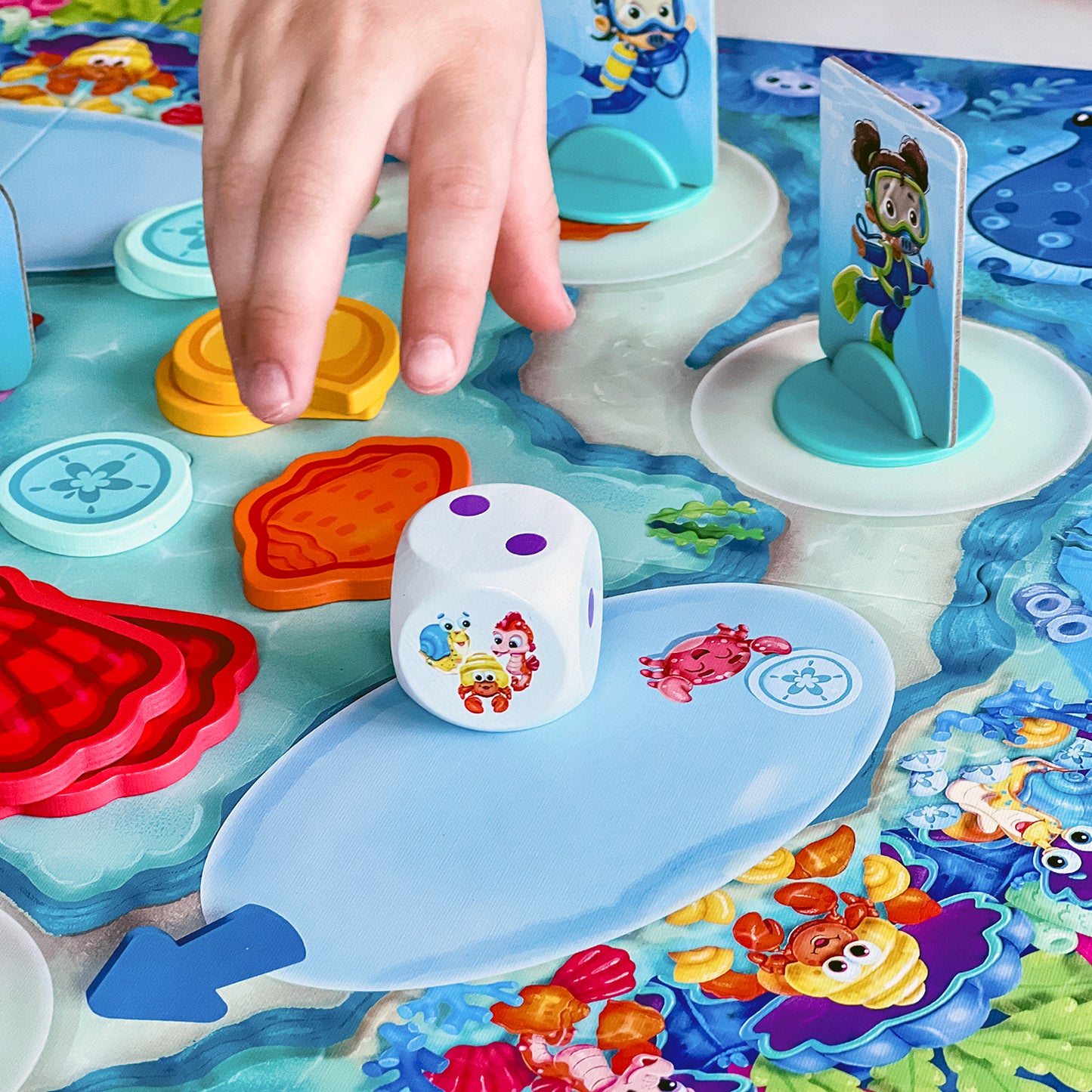
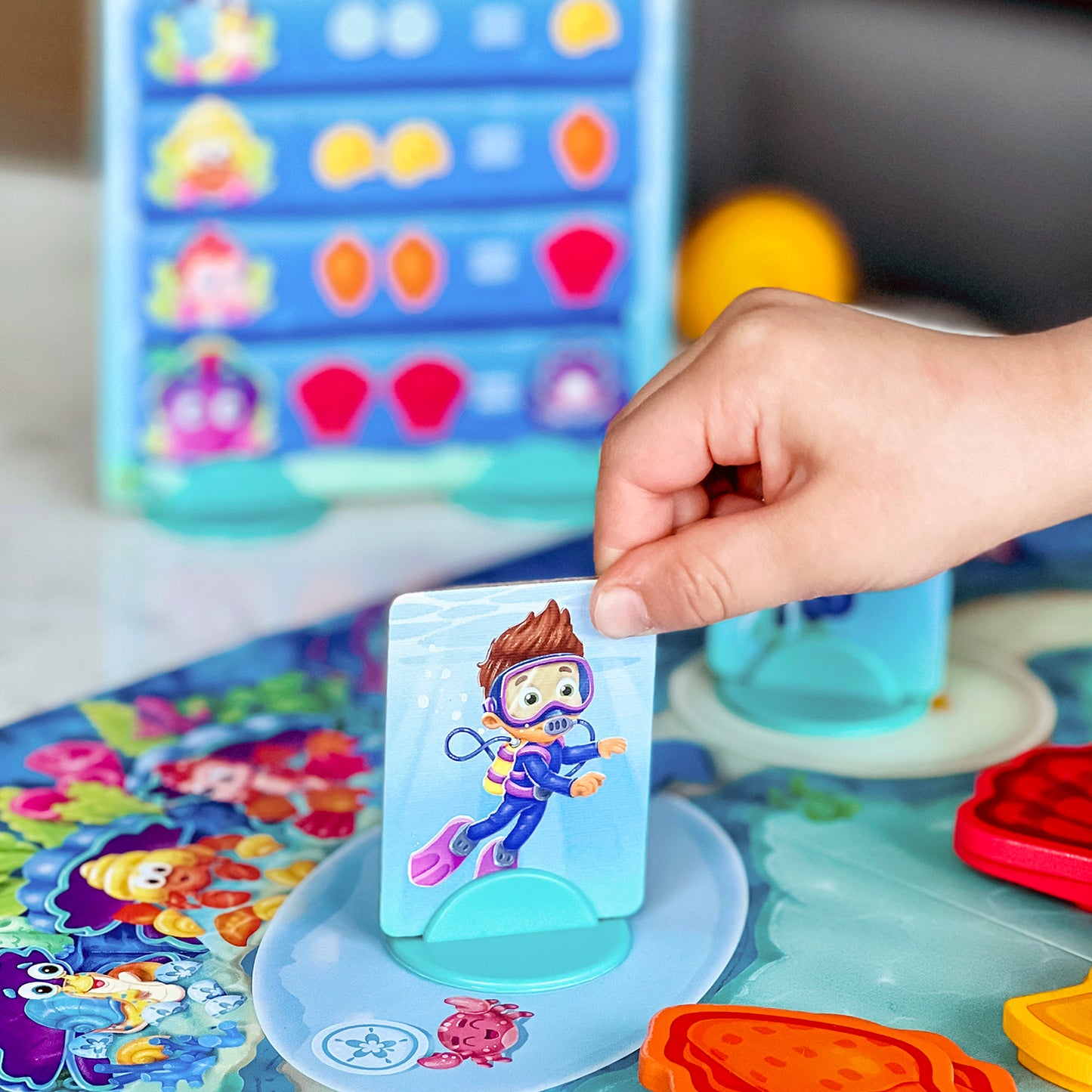
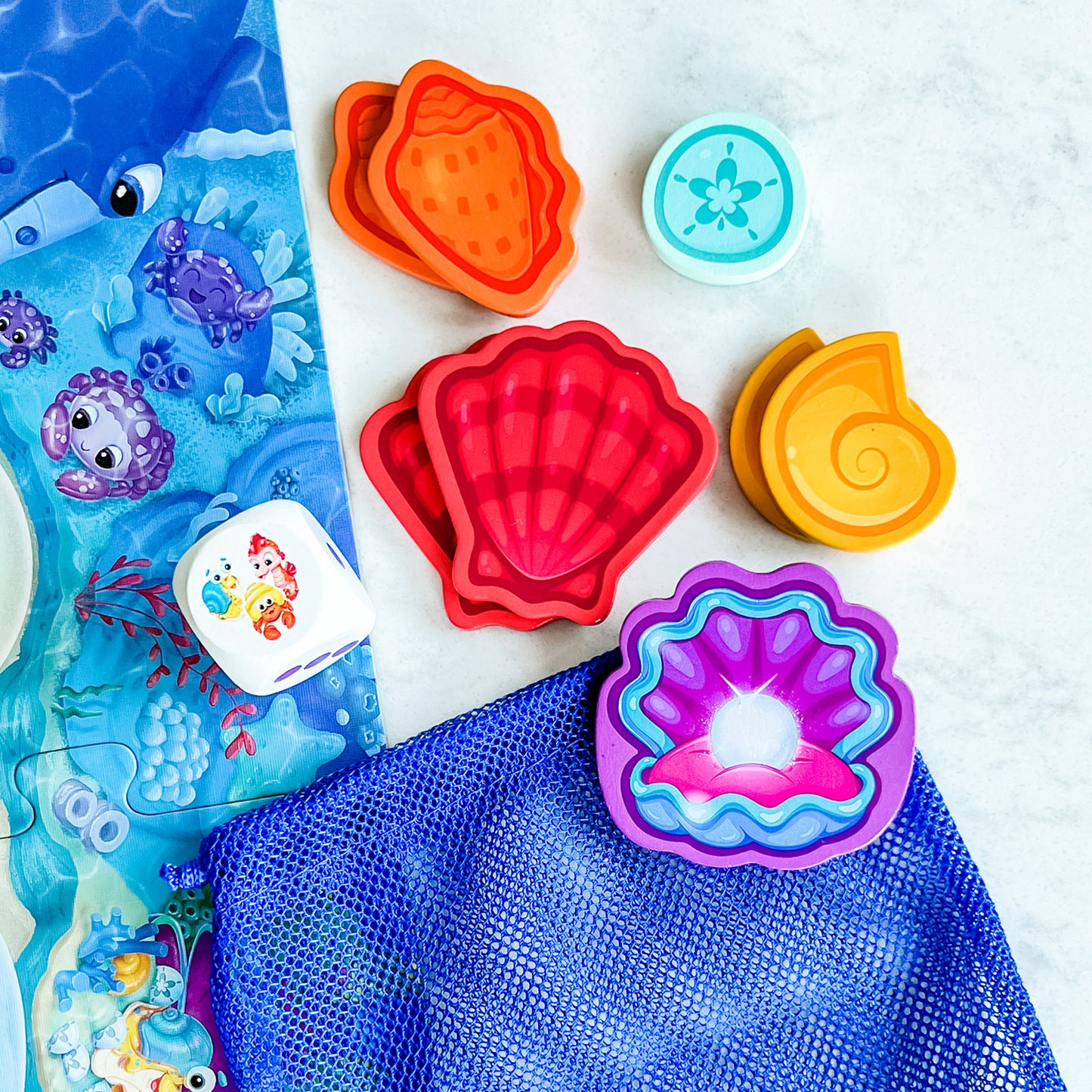




Collapsible content
How to Play
Educational Standards
Not available for this product
Skills
Determine
What Does Child Do To Use Skill In The Game?
Depending on the bubble they land on the board and the types of shells they have in their collection bag, players determine which shell to pick up or which to trade for a more important shell. Additionally, with each roll of the die, players determine where to move their diver pawn.
How Parents Can Assist Learning
It may be easier for some children visualize what to do when landing on a trading bubble to stack shells in front of them, rather than use the collection bag.
Also, if you notice that a child is not trading up, show them how to do that the next time they land on a trading bubble.
Learning Implications and Educator Support
Shelly's Pearl introduces the concept of "equals" by having two of a shell equal one of a more important shell.
It may be easier for some children visualize what to do when landing on a trading bubble to stack shells in front of them, rather than use the collection bag.
Also, if you notice that a child is not trading up, show them how to do that the next time they land on a trading bubble.
Compare
What Does Child Do To Use Skill In The Game?
Shelly's Pearl is primarily a comparing game as players visually compare images on the game and shell trading boards with the foam shells, as well as comparing the shells in their collection bag to determine if they can trade for a more important shell.
How Parents Can Assist Learning
It may be easier for some children visualize what to do when landing on a trading bubble to stack shells in front of them, rather than use the collection bag.
Also, if you notice that a child is not trading up, show them how to do that the next time they land on a trading bubble.
Learning Implications and Educator Support
Shelly's Pearl provides children with different ways to visually compare and match images with foam shells.
It may be easier for some children visualize what to do when landing on a trading bubble to stack shells in front of them, rather than use the collection bag.
Also, if you notice that a child is not trading up, show them how to do that the next time they land on a trading bubble.
*Data compiled from CCSSI ELA Standards, WA Science Standards, and Washington Social Studies Standards
Special Needs
Cognitive
Suggestions for How to Modify Play Experience
Children with cognitive challenges can play Shelly’s Pearl if they can count to two and have other players’ guide them to refer to the Shell Trading card and support the player’s thinking about what their shells can be traded for.
Communication
Suggestions for How to Modify Play Experience
Although players don’t need to talk to each other during the game, players should be encouraged to identify what shells they have picked up, and when they trade up, they can be encouraged to learn the mathematical term “equal.” For example, “Two blue shells equal one yellow shell.”
Sensorimotor
Suggestions for How to Modify Play Experience
Pieces are large and should be easy to handle, unless the child has a great deal of difficulty with moving the diver pawns, picking up the shells, and putting them into the bag. If this is the case, the player may have assistance from another player moving their pawn and then place the shells on the table in front of the player instead of the bag.
Social Emotional/Behavioral
Suggestions for How to Modify Play Experience
Shelly’s Pearl should not be too frustrating to play. Directions are easy to follow, and the Shell Trading card clearly lays out the options. If the child has difficulty with waiting for their turn, encourage them to count other players moves along with them and help them think about the number of shells they have. This helps the child divert his attention from themselves to other players, which helps the child learn to appreciate others’ needs.
Vision
Suggestions for How to Modify Play Experience
The board has large visual bubbles for the pawns and the shells are bright colors. If more delineation is needed, use a black marker to color around the bubbles on the board. This will help enhance the contrast between the background board and each space for the pawns to move.
Hearing
Suggestions for How to Modify Play Experience
Hearing concerns should not inhibit play. Use physical demonstration with the actual game pieces to demonstrate how to play the game play before starting.
*Data compiled from CCSSI ELA Standards, WA Science Standards, and Washington Social Studies Standards
Autism
Autism Strengths & Interests
Short Summary of Strengths & Interests
- Compare and Match
- Math Concept of Equal
- Achieving Goals
Is good at matching visual items
Is This Game Appropriate? Yes
Description
Has a good memory for sensory details, including visual, touch, taste and smell
This game is not appropriate
Has a good memory for words, phrases and dialouge
This game is not appropriate
Has a good memory for pictures, numbers and patterns
This game is not appropriate
Likes to put things in order or a sequence
Is This Game Appropriate? Yes
Description
Shelly's Pearl requires matching and trading for higher value shells, following a sequence shown on the Shell Trading card. This requires visual matching in a sequential order.
Learns through visualizing or "replaying" actions in their mind
This game is not appropriate
Likes activities with rules, such as math and phonics
Is This Game Appropriate? Yes
Description
Simple rules are involved with progressive values of shells.
Is very concrete and literal
Is This Game Appropriate? Yes
Description
Shelly's Pearl is very concrete and literal. Diver Pawns and shells are manipulated in a specific sequence shown on the Shell trading card.
Learns in small "chunks" (for example, phone numbers are 3 chunks of number xxx-xxx-xxxx that are combined together)
Is This Game Appropriate? Yes
Description
Players gather like shells in sets of two in a required order.
Is good at nonverbal reasoning and logic
Is This Game Appropriate? No
Description
Reasoning is not needed, as the order for play is clearly displayed. In the more advanced instructions, some reasoning is involved, as players need to determine which direction to move their diver to gain the shells they need.
Likes spatial problem solving
Is This Game Appropriate? No
Description
No spatial problem solving is needed for the primary version of Shelly's Pearl. In the more advanced instructions, some reasoning is involved, as players need to determine which direction to move their diver to gain the shells they need.
Can read well with good vocabulary, though may not fully comprehend content
This game is not appropriate
Likes to use and has good fine motor skill
Is This Game Appropriate? Yes
Description
Players need to manipulate their diver and their shells. The shells are large, however, so precise manipulation is not needed.
Likes established routines or set ways of doing things
Is This Game Appropriate? Yes
Description
The game is played the same way each time, so a routine of play is established. This game is not appropriate
Likes manipulating, constructing or building things
This game is not appropriate
Likes to use and has good musical abilities
This game is not appropriate
Likes to use and has good drawing skills
This game is not appropriate
Autism Special Considerations
Appears to ignore other's communication and/or has difficulty giving eye contact to a communication partner
Is This Game Appropriate for Child with Characteristic? Yes
Can Child with Characteristic Play Game w/o Modification? Yes
Strategies for Developing Compensatory Skills:
Players do not have to give eye contact or communicate with other players.
Has difficulty understanding complex verbal directions
Is This Game Appropriate for Child with Characteristic? Yes
Can Child with Characteristic Play Game w/o Modification? Yes
Strategies for Developing Compensatory Skills:
The directions for Shelly's Pearl are not difficult. Players only need to make pairs of shells and trade them for higher value shells.
Uses vocabulary inaccurately or demonstrates echolalia (repeating another's speech)
Is This Game Appropriate for Child with Characteristic? Yes
Can Child with Characteristic Play Game w/o Modification? Yes
Strategies for Developing Compensatory Skills:
Unless the echolalia is extensive and totally off topic, it should not interfere with other players turns. Discussion and concentration is not necessary for this game, so echolalia of what other players are saying should not bother them.
Gets stuck repeating a verbal topic or physical actions and/or has difficulty attending to others' actions or topic.
Is This Game Appropriate for Child with Characteristic? Yes
Can Child with Characteristic Play Game w/o Modification? Yes
Strategies for Developing Compensatory Skills:
There is no strategy involved in playing Shelly's Pearl, unless the more challenging version is played. Therefore, distracting talk or actions should not interfere with game play.
Has difficulty producing speech/communication
Is This Game Appropriate for Child with Characteristic? Yes
Can Child with Characteristic Play Game w/o Modification? Yes
Strategies for Developing Compensatory Skills:
Communication is not needed to play the game, but discussion about the different shells in the game may enhance the play. Encourage players to talk about the shells they want to get next by looking at the Shell Trading card.
Has difficulty sequencing multi-step actions and/or doing complex abstract tasks
Is This Game Appropriate for Child with Characteristic? Yes
Can Child with Characteristic Play Game w/o Modification? Yes
Strategies for Developing Compensatory Skills:
Each turn is simple, involving throwing the dice, moving the number of bubbles indicated on the die, and picking up or trading shells.
Demonstrates difficulty initiating and maintaining social interactions
Is This Game Appropriate for Child with Characteristic? Yes
Can Child with Characteristic Play Game w/o Modification? Yes
Strategies for Developing Compensatory Skills:
Interaction with other players is not necessary, but should be encouraged.
Acts out or demonstrates avoidance behaviors when frustrated, overwhelmed, or needs more sensory input.
Is This Game Appropriate for Child with Characteristic? Yes
Can Child with Characteristic Play Game w/o Modification? Yes
Strategies for Developing Compensatory Skills:
Shelly's Pearl should not be frustrating, as it moves quickly. If too much discussion is taking place between the player with autism's turns, they may become anxious. Allow fidget breaks if needed, or speed up the play.
Has short attention span for non-preferred activities
Is This Game Appropriate for Child with Characteristic? Yes
Can Child with Characteristic Play Game w/o Modification? Yes
Strategies for Developing Compensatory Skills:
The child with autism may enjoy matching the shells. Use fidget toys between turns.
Needs sameness or consistent routines and/or has difficulty with transitions from one activity to another
Is This Game Appropriate for Child with Characteristic? Yes
Can Child with Characteristic Play Game w/o Modification? Yes
Strategies for Developing Compensatory Skills:
The routine of play is the same with each turn, so this structure may be comforting.
Has difficulty understanding others' feelings, intentions, and the reasons for others' actions.
Is This Game Appropriate for Child with Characteristic? Yes
Can Child with Characteristic Play Game w/o Modification? Yes
Strategies for Developing Compensatory Skills:
Shelly's Pearl does not require understanding others' feelings or intentions. The child with autism can be encouraged to notice others' smiles as they make a trade.
*Data compiled from CCSSI ELA Standards, WA Science Standards, and Washington Social Studies Standards
Extended Play
Extra Ways to Play the Game
Make Shelly's Pearl into a beginning addition game. The game is played the same way, but the shells collected each have a numerical value. The goal is to be the first person to collect shells to equal to 2 through 10.
Make a new Shell Trading card with assigned values for each shell and a total on the right side.
The left side of the Shell card would have:
1. sand dollar = 1
2. snail shell = 2
3. bonnet shell = 3
4. scallop shell = 4
The right side of the Shell card would have boxes with totals listed from 2 to 10.
On their turn, players try to collect shells so their combined values equal a number on their new Shell Trading card. For example, 1 + 2 + 3 = 6; or 3 + 3 = 6; or 4 + 2 = 6, etc.
Players all confirm if the addition was accurate. After a player correctly creates a formula to equal a number they need, they return those shells to the game board.
The first person to complete finding each of the total values wins.
Materials Needed
Make a new Shell card with assigned values for each shell and a total on the right side. The left side of the Shell card would have:
1. sand dollar = 1
2. snail shell = 2
3. bonnet shell = 3
4. scallop shell = 4
Developmental Benefits
This modification provides a concrete way for children to see that numbers (totals) can be composed in numerous ways. It also gives them practice in writing numbers and a simple equation. If needed, they can use the pips on the dice that correspond to the value of the shells they have to count or visually check their totals.
*Data compiled from CCSSI ELA Standards, WA Science Standards, and Washington Social Studies Standards
Collapsible content
How to Play Video & Transcript
A game that has you and your dive team swimming around the board collecting shells to trade with Shelly the octopus.
You can play Shelly’s Pearl with 2-4 players, ages 4 and up!
Shelly’s Pearl is great for developing Trading Skills, as players exchange two smaller shells for a larger shell learning that smaller values can combine to make larger values.
Shelly’s Pearl also helps with Achieving Goals as players collect and exchange shells working toward collecting the final prize shell.
Shelly’s personal pronouns are they/them and we encourage you to refer to Shelly this way as you play the game.
To set up the game,
• Assemble the gameboard in the middle of the play area where everyone can reach.
• Place Shelly the octopus in the center of the board, and the four prize shells inside the box.
• Each player chooses a diver pawn and a collection bag. Place your pawn on the starting space indicated by the green arrow.
• Give each player one blue shell to place in their collection bag.
• Place the rest of the seashells around the gameboard.
• The first player to name an animal that lives in the ocean goes first.
The object of Shelly’s Pearl is to collect seashells while swimming around the board. When a player reaches one of the three trading bubbles, they collect a blue shell and trade their smaller shells for larger ones. When a player has collected two of the largest red shells, they trade up for Shelly’s pearl. The other players continue to play until everyone has collected their prize pearl.
On your turn, roll the die and take one of the following actions:
If you roll a side showing dots, count the dots on top. These sides represent the numbers 1, 2, 3 or 4. Move your diver in the direction of the arrows, according to the number rolled.
Each of the bubbles on the gameboard counts as one space, including the trading bubbles. You may pass other divers along the path, and you may stop on spaces with another diver.
The two trading-bubble symbols on the die, featuring Shelly’s friends, allows your diver to move ahead to the next trading bubble on the board.
If you stop on a space with one or two seashells, collect the shell(s) shown on that space from the board and place them in your collection bag. This ends your turn.
Even if you have collected a pair of shells, you may not trade-up until you stop at one of the three trading bubbles.
When you stop on a trading bubble or when you roll the trading bubble symbol and move your diver to the next trading bubble, collect one blue shell and then you may trade-up any of the pairs of shells you have collected according to the shell trading card.
Two blue shells = One yellow shell
Two yellow shells = One orange shell
Two orange shells = One red shell
and Two red shells = One prize shell
NOTE: You can do multiple trades on your turn if you have the correct number of shells needed for each trade. As you make trades, you may find that you can trade-up again and again!
Return the two shells you are trading to the board and collect the new shell you are trading-up to and place it in your collection bag.
You may not trade if you are just passing through one of the trading bubbles.
After completing your turn, pass the die to the player on your left, and play continues clockwise.
When a player has traded in their two large red shells and collected their prize shell from Shelly, they return any remaining shells in their bag to the board.
That player continues to play by helping the other divers earn their prize shells. On future turns, offer any shells collected to another diver. If collecting two shells you may give one to different divers or both to the same diver. If you land on a trading bubble, collect a blue shell, and offer it to another diver. The game ends when everyone has collected their prize shells and can shellebrate together!
Enjoy exploring the ocean floor and collecting colorful shells as you trade with Shelly for their prize with Simply Fun’s Shelly’s Pearl!
- Choosing a selection results in a full page refresh.
- Opens in a new window.

